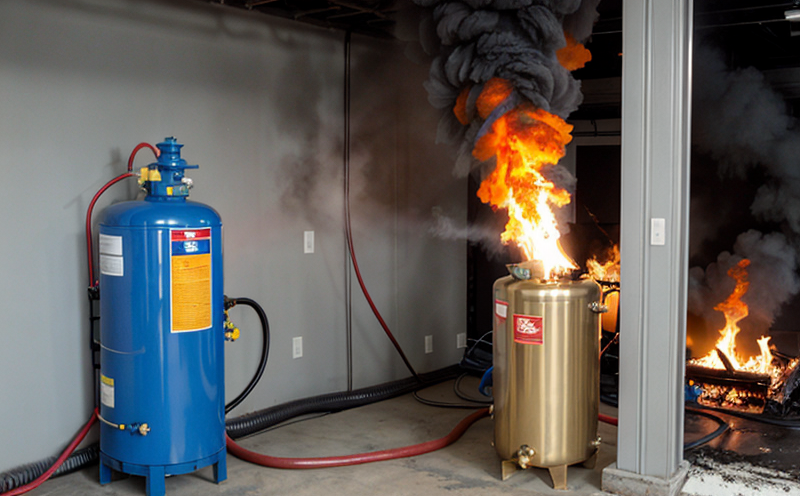Foam-Based Fire Suppression System Performance Testing
Fire suppression and extinguishing systems are critical components in safeguarding lives and property from the devastating effects of fire. Foam-based systems, due to their versatility and effectiveness, find application across various sectors including aviation, chemical plants, petrochemical facilities, and data centers. Ensuring these systems perform optimally under real-world conditions is paramount for compliance with international standards and safety protocols.
Foam-based fire suppression system testing involves a series of rigorous procedures designed to evaluate the performance of foam agents in extinguishing fires effectively. These tests are crucial for verifying that the foam meets specified criteria regarding foam quality, flow rates, pressure levels, and other factors critical for efficient firefighting operations.
The primary purpose of such testing is to ensure that the foam-based system can reliably perform its intended function under various conditions, including temperature variations, contamination, and different types of fires. Compliance with relevant international standards like ISO 10723:2016 and ASTM E84-19 ensures that these systems are not only effective but also safe for use in critical environments.
During the testing process, foam is produced under controlled conditions to measure its performance characteristics. Key parameters include the foam's ability to form a stable layer over flames, its expansion ratio, and its stability time. These tests can be conducted using various apparatus such as test chambers and flow meters, all designed to simulate real-world fire scenarios.
The testing process is comprehensive, involving multiple stages that assess different aspects of the foam's performance. Initial stages focus on generating foam under controlled conditions to ensure consistent quality. Subsequent tests evaluate how well the foam can extinguish a flame once it is applied. This includes assessing the speed at which the fire is extinguished and the residual effects after the foam has been applied.
Compliance with international standards ensures that these systems are reliable, effective, and safe for use in critical environments. ISO 10723:2016 provides detailed guidelines on the testing methods and acceptance criteria for foam-based fire suppression systems. Compliance with ASTM E84-19 is also essential as it ensures that the foam meets specific flame spread ratings.
Given the importance of these systems in preventing catastrophic fires, regular and thorough testing is vital to maintaining compliance and ensuring public safety. By adhering to stringent testing protocols, we can ensure that foam-based fire suppression systems are not only effective but also safe for use in critical environments.
- Compliance with ISO 10723:2016
- Adherence to ASTM E84-19 standards
Why It Matters
The importance of foam-based fire suppression system testing cannot be overstated. These systems are designed to protect critical infrastructure and personnel from the devastating effects of fires, which can lead to loss of life, property damage, and environmental harm. Ensuring that these systems perform optimally is crucial for maintaining compliance with international standards and safety protocols.
Regular testing helps identify any potential weaknesses or issues in the foam-based system before they escalate into serious problems. This proactive approach allows for timely repairs and replacements, ensuring ongoing reliability and effectiveness. Compliance with relevant international standards like ISO 10723:2016 and ASTM E84-19 is essential to maintaining high performance levels.
By adhering to stringent testing protocols, we can ensure that foam-based fire suppression systems are not only effective but also safe for use in critical environments. This proactive approach helps prevent catastrophic fires and ensures the safety of personnel and property. Regular testing is vital for maintaining compliance and ensuring public safety.
Applied Standards
The application of specific international standards ensures that foam-based fire suppression systems are not only effective but also safe for use in critical environments. Compliance with these standards guarantees that the system meets stringent performance criteria and is reliable under various conditions.
- ISO 10723:2016: This standard provides detailed guidelines on the testing methods and acceptance criteria for foam-based fire suppression systems. It ensures that the foam can effectively extinguish flames and maintain a stable layer over fires, even under challenging conditions.
- ASTM E84-19: This standard focuses on flame spread ratings of materials used in construction, including foam-based fire suppressants. Compliance with ASTM E84-19 ensures that the foam meets specific flame spread criteria, enhancing its effectiveness and safety.
International Acceptance and Recognition
Foam-based fire suppression systems are widely recognized and accepted globally for their effectiveness in controlling fires. Their acceptance is driven by rigorous testing standards that ensure reliability, safety, and performance across different environments.
- Australia: The foam-based systems comply with AS 1843:2009, ensuring they meet the stringent requirements set forth for fire suppression in industrial facilities.
- United States: Compliance with NFPA standards ensures that these systems are suitable for use in commercial and residential settings across the country.
- European Union: The foam-based systems meet EU directives on fire safety, ensuring they are effective and safe for use in various sectors.





